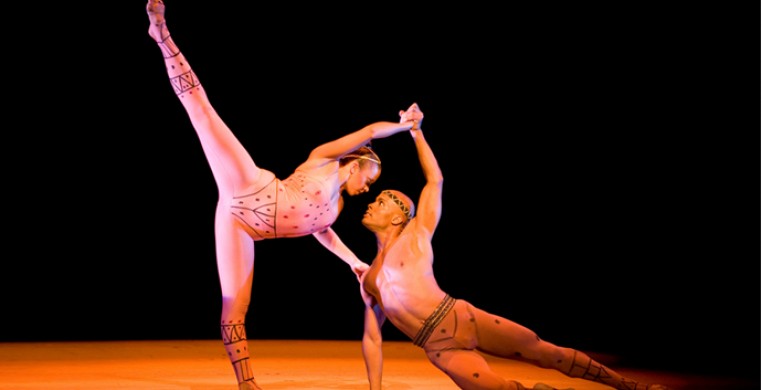By Lynn Colburn Shapiro
When native Chicagoan Vernard J. Gilmore first saw Alvin Ailey American Dance Theater performing in his hometown, he said, “I need to be there!” Gilmore saw himself, and the world in which he lived, in the characters portrayed onstage, and he dreamed of one day becoming a member of the company. Today, as he anticipates returning to dance at the Auditorium Theatre in the company’s annual Chicago engagement, he has been living that dream for twenty years.
“It’s rejuvenating to come home to Chicago,” Gilmore says. “Being in the Midwest, people say hello to you. There’s real acknowledgement on the street that you are a person.” Here, he says, “I understand who I am.” Growing up in Chicago’s Engelwood neighborhood, he remembers his mother dancing in the annual Engelwood parade. “There was always dance,” he said, but it wasn’t until he was 17 years old and a student at Chicago’s Curie Creative and Performing Arts High School that he began formal training through “Chance To Dance.” It wasn’t long before he was studying with Harriet Ross of the Joseph Holmes Chicago Dance Theatre, and Eileen Cropley, formerly of the Paul Taylor Dance Company, at Barat College. In 1995, GIlmore was accepted into Ailey II, and by 1997 he was promoted to the senior company.
Being in Ailey is intense, he says. “You have to make a full commitment,” with a work ethic that emphasizes individual integrity and artistic originality. “Mr Ailey didn’t like cookie-cutter dancers.” While Gilmore began with the Ailey company under the direction of Judith Jamison, the founding director’s vision and aesthetic were always a palpable presence. “He really wanted you to color the movement, and (he encouraged) you in a way that made you access your own sensibilities.” In the company, “you always feel like you’re growing as an artist.” Gilmore especially values the freedom the dancers are given “to be whomever you want to be on stage.” Under Robert Battle’s direction, Ailey’s mission, to deliver dance back to the people, continues to be an active force in the company’s development. Dancing in the company, you really begin to see “how you can affect the world.”
In 2008, Alvin Ailey American Dance Theater was designated, by a U.S. Congressional resolution, as “a vital American cultural ambassador to the world,” one that celebrates the uniqueness of the African-American experience and the preservation and enrichment of the American modern dance heritage. Last December, Battle visited the White House to accept the Presidential Medal of Freedom--the nation’s highest civilian honor--on behalf of Alvin Ailey. President Obama proclaimed that “through him, African-American history was told in a way that it had never been told before--with passionate, virtuoso dance performances that transfixed audiences worldwide.”
Today, as a multi-cultural company, and in the spirit of Alvin Ailey’s stated goal of incorporating many different choreographic voices into the company repertory, programming has expanded to include choreographers from around the world. For its 9-performance Chicago engagement, March 6-15, the company will present three different programs.
Program A will feature its new civil-rights-themed piece, “Odetta,” a world premiere choreographed by Ailey dancer Matthew Rushing in conjunction with the 50th anniversary of the Civil Rights Act, and set to the musical repertoire of one of the most influential singers and civil rights activists of the 20th century, Odetta Holmes. The program will also include, Ulysses Dove’s “Episodes,” (1989) set to a percussive score by Robert Ruggieri, and Alvin Ailey’s iconic “Revelations” (1960), which will conclude each of the three programs.
Program B will present Dutch choreographer Hans van Manen’s “Polish Pieces” (1995), set to music by Henryk Mikolaj Górecki. Robert Battle comments: “Hans van Manen’s work has a great sense of humor and mischief in it. He’s a master of creating grand kaleidoscopic works from very simple motifs. “Polish Pieces” has allusions of folk dance, which give it a timeless feeling that’s a wonderful compliment to our repertory.” In addition to “Revelations,” a revival of African choreographer Asadata Dafora’s history-making 1932 solo, “Awassa,” and Dove’s duet “Bad Blood” (1986) complete the program.
Program C brings Robert K. Brown’s “Grace” (1999), using music by Duke Ellington, Roy Davis Jr., Paul Johnson & Fela Anikulapo Kuti in a blend of modern dance and West African idioms. Israeli-born Hofesh Scheechter’s “Uprising” (2006) is set to a percussive score composed by the choreographer, with additional music by Vex’d. Christopher Wheeldon’s sensual duet, “After The Rain” (2005), performed most often by classical ballet companies, is well-suited to the style and capabilities of Ailey, with “Revelations” rounding out the program.
Gilmore, who dances “Wade In The Water,” “I Want To Be Ready,” and “Sinner Man” segments in “Revelations,” counts it as his favorite piece to dance. “It never fails to stir something in me every time. I can be so tired, but you can use that exhaustion, that sadness, because (the piece) transcends struggle with hope and joy.” You can catch Vernard Gilmore in “Grace” and “Polish Pieces” as well. In addition, Gilmore will be teaching adult master classes Saturday, March 14th at the Auditorium, and will moderate the two student performances, Thursday and Friday, March 12th and 13th.
When asked how audiences differ among the 19 cities the company is touring between February 3 and June 21, Gilmore laughs. “Chicago Audiences--everyone goes CRAZY!”
For further details, go to seechicagodance.com, and click on “Upcoming Events.”

